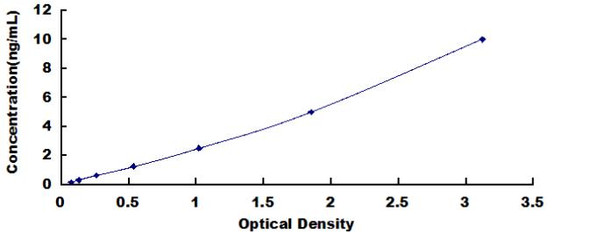Description
ENPP1 Antibody (PACO09096)
The ENPP1 Polyclonal Antibody (PACO09096) is a valuable tool for researchers studying ENPP1, a key enzyme involved in mineralization and the formation of bone mineral density. This antibody, generated in rabbits, displays high specificity for human samples and has been validated for use in applications such as Western blotting.ENPP1, also known as ectonucleotide pyrophosphatase/phosphodiesterase 1, plays a crucial role in the regulation of phosphate and pyrophosphate levels in the body, affecting various physiological processes including bone formation and insulin signaling.
Dysregulation of ENPP1 has been implicated in diseases such as arteriosclerosis, insulin resistance, and nephrolithiasis, making it a promising target for therapeutic interventions.By using the ENPP1 Polyclonal Antibody, researchers can accurately detect and analyze ENPP1 protein levels in different cell types, paving the way for further insights into its role in mineralization and metabolic disorders. This antibody is a valuable asset for studies in the fields of bone biology, metabolism, and cardiovascular diseases.
| Antibody Name: | ENPP1 Antibody (PACO09096) |
| Antibody SKU: | PACO09096 |
| Size: | 50ul |
| Host Species: | Rabbit |
| Tested Applications: | ELISA, WB |
| Recommended Dilutions: | |
| Species Reactivity: | Human, Mouse, Rat |
| Immunogen: | Human ENPP1 |
| Form: | Liquid |
| Storage Buffer: | PBS with 0.1% Sodium Azide, 50% Glycerol, pH 7.3. -20°C, Avoid freeze / thaw cycles. |
| Purification Method: | Antigen Affinity purified |
| Clonality: | Polyclonal |
| Isotype: | IgG |
| Conjugate: | Non-conjugated |
| Synonyms: | ectonucleotide pyrophosphatase/phosphodiesterase 1;ENPP1;M6S1;NPP1;NPPS;PC-1;PCA1;PDNP1 ; |
| UniProt Protein Function: | ENPP1: Involved primarily in ATP hydrolysis at the plasma membrane. Plays a role in regulating pyrophosphate levels, and functions in bone mineralization and soft tissue calcification. In vitro, has a broad specificity, hydrolyzing other nucleoside 5' triphosphates such as GTP, CTP, TTP and UTP to their corresponding monophosphates with release of pyrophosphate and diadenosine polyphosphates, and also 3',5'-cAMP to AMP. May also be involved in the regulation of the availability of nucleotide sugars in the endoplasmic reticulum and Golgi, and the regulation of purinergic signaling. Appears to modulate insulin sensitivity. Homodimer; disulfide-linked. Interacts with INSR. Expressed in plasma cells and also in a number of non-lymphoid tissues, including the distal convoluted tubule of the kidney, chondrocytes and epididymis. At low concentrations of ATP, a phosphorylated intermediate is formed which inhibits further hydrolysis. Belongs to the nucleotide pyrophosphatase/phosphodiesterase family. |
| UniProt Protein Details: | Protein type:Membrane protein, integral; Cofactor and Vitamin Metabolism - nicotinate and nicotinamide; Nucleotide Metabolism - purine; Cofactor and Vitamin Metabolism - pantothenate and CoA biosynthesis; EC 3.1.4.1; Phosphatase (non-protein); Motility/polarity/chemotaxis; Carbohydrate Metabolism - starch and sucrose; Cofactor and Vitamin Metabolism - riboflavin; Phosphodiesterase; EC 3.6.1.9 Chromosomal Location of Human Ortholog: 6q22-q23 Cellular Component: extracellular space; cell surface; lysosomal membrane; integral to plasma membrane; basolateral plasma membrane; integral to membrane; plasma membrane Molecular Function:phosphodiesterase I activity; nucleotide diphosphatase activity; protein homodimerization activity; 3'-phosphoadenosine 5'-phosphosulfate binding; zinc ion binding; calcium ion binding; nucleoside-triphosphate diphosphatase activity; insulin receptor binding; polysaccharide binding; protein binding; nucleic acid binding; scavenger receptor activity; ATP binding Biological Process: receptor-mediated endocytosis; generation of precursor metabolites and energy; sequestering of triacylglycerol; vitamin metabolic process; nucleoside triphosphate catabolic process; negative regulation of insulin receptor signaling pathway; bone remodeling; negative regulation of fat cell differentiation; phosphate metabolic process; 3'-phosphoadenosine 5'-phosphosulfate metabolic process; riboflavin metabolic process; negative regulation of glucose import; cellular phosphate ion homeostasis; cellular response to insulin stimulus; biomineral formation; negative regulation of ossification; immune response; negative regulation of protein amino acid autophosphorylation; negative regulation of cell growth; regulation of bone mineralization; water-soluble vitamin metabolic process; inorganic diphosphate transport; negative regulation of glycogen biosynthetic process Disease: Obesity; Cole Disease; Arterial Calcification, Generalized, Of Infancy, 1; Hypophosphatemic Rickets, Autosomal Recessive, 2; Diabetes Mellitus, Noninsulin-dependent |
| NCBI Summary: | This gene is a member of the ecto-nucleotide pyrophosphatase/phosphodiesterase (ENPP) family. The encoded protein is a type II transmembrane glycoprotein comprising two identical disulfide-bonded subunits. This protein has broad specificity and cleaves a variety of substrates, including phosphodiester bonds of nucleotides and nucleotide sugars and pyrophosphate bonds of nucleotides and nucleotide sugars. This protein may function to hydrolyze nucleoside 5' triphosphates to their corresponding monophosphates and may also hydrolyze diadenosine polyphosphates. Mutations in this gene have been associated with 'idiopathic' infantile arterial calcification, ossification of the posterior longitudinal ligament of the spine (OPLL), and insulin resistance. [provided by RefSeq, Jul 2008] |
| UniProt Code: | P22413 |
| NCBI GenInfo Identifier: | 23503088 |
| NCBI Gene ID: | 5167 |
| NCBI Accession: | P22413.2 |
| UniProt Related Accession: | P22413 |
| Molecular Weight: | |
| NCBI Full Name: | Ectonucleotide pyrophosphatase/phosphodiesterase family member 1 |
| NCBI Synonym Full Names: | ectonucleotide pyrophosphatase/phosphodiesterase 1 |
| NCBI Official Symbol: | ENPP1 |
| NCBI Official Synonym Symbols: | M6S1; NPP1; NPPS; PC-1; PCA1; ARHR2; COLED; PDNP1 |
| NCBI Protein Information: | ectonucleotide pyrophosphatase/phosphodiesterase family member 1 |
| UniProt Protein Name: | Ectonucleotide pyrophosphatase/phosphodiesterase family member 1 |
| UniProt Synonym Protein Names: | Membrane component chromosome 6 surface marker 1; Phosphodiesterase I/nucleotide pyrophosphatase 1; Plasma-cell membrane glycoprotein PC-1Including the following 2 domains:Alkaline phosphodiesterase I (EC:3.1.4.1); Nucleotide pyrophosphatase (EC:3.6.1.9); NPPase |
| Protein Family: | Ectonucleotide pyrophosphatase/phosphodiesterase family |
| UniProt Gene Name: | ENPP1 |
| UniProt Entry Name: | ENPP1_HUMAN |










